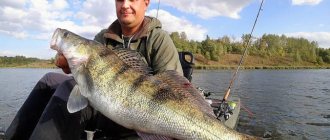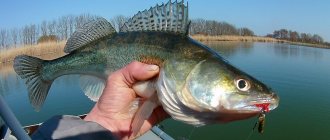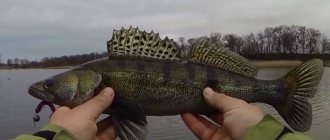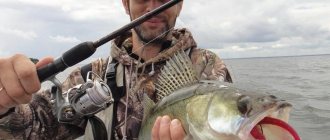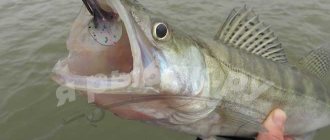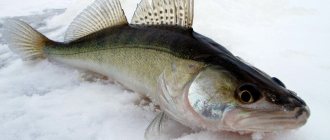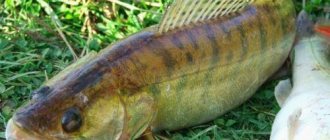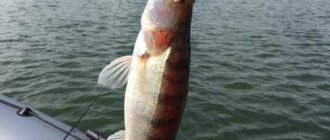Yuri 12/22/2020 282
Pike perch is an energetic fish, you can catch it at any time of the day, but the peak of its activity occurs in the dark and at night. He spends the pre-dawn hours in shallow water in search of prey, and it is at these moments that he is most likely to be interested in bait.
However, poor visibility due to darkness prevents the use of almost all types of gear. In this case, a bottom rubber band for pike perch is ideal for successful fishing at night. The leisurely pace of fishing allows you to spend quiet time on the shore without much effort, but with a promising forecast for a good catch, which makes this type of fishing very comfortable.
Using tackle for catching pike perch
Pike perch is active around the clock, but its peak occurs in the dark. At night and in the early morning hours, pike perch likes to hunt in shallow water. It is at this time that fish may become interested in potential prey in the form of bait. However, in this case, due to poor visibility at night, most gear (for example, spinning rods) is difficult to use, to put it mildly.
The use of rubber-type gear will allow you to catch this fish without any problems while being on the shore even throughout the night. The fishing process is quite calm, one might even say that this is fishing for the lazy.
Advantages and disadvantages
The advantages of fishing with an elastic band include the following:
- the tackle is installed and removed once during the entire fishing period;
- thanks to the cushioning of the elastic band, the fishing line does not break;
- there is no need to throw gear into the water after each bite and fishing;
- elastic band - silent tackle; it does not make any noises that scare away potential prey;
- fishing can last a very long time; at the same time, you can easily control several gears at once;
- In addition to pike perch, you can catch other fish. To do this, just change the hooks and attachments.
Fishing with a rubber band
Donka-elastic band is usually used for a certain range of peaceful and predatory fish. Among the main “victims” of gum are:
- crucian carp;
- perch;
- roach;
- saberfish;
- gudgeon;
- zander;
- carp;
- pike.
It is possible to quickly reorient the tackle by replacing the leads. So, after catching pike perch, it is enough to install leashes 0.18-0.2 mm thick with appropriate hooks to switch to catching crucian carp or perch.
A guide to catching saberfish with a rubber band - what bait to use and how the process of catching the most attractive fish for fishing with a rubber band is structured. We make donka with our own hands - three varieties in our detailed article.
There is also no need to make the leashes heavier; the weight of the hook and bait is enough for the bait to end up in the lower layer of water. When fishing on a lake or pond, you can use an elastic band of a smaller diameter; in many cases, it is enough to use a shock absorber with a thickness of 3 - 4 mm.
The most common type of fish for rubber band fishing is saberfish. At night, fishing for pike perch will be successful.
From April until June, you can catch crucian carp in reservoirs. Pike, bream, silver bream, ide and other types of fish are also caught.
Catching predatory fish with a rubber band
The elastic should include a thick thread to which up to five leashes are attached. You also need to use an aircraft model rubber band (a short piece) and a sinker, the minimum weight of which should be 200 grams.
Catching sabrefish with an elastic band
In the summer, it is better to fish in shallow water, mainly flocks of sabrefish will feed there until the fall.
Rubber band device for catching sabrefish:
- The sinker can be a massive lead part. You need to attach a strong rope (0.5 - 1 m) to it.
- The elastic band must be of very high quality, without any defects. After wetting the ends of the elastic, you need to make a couple of loops using a double knot.
- You need to add several swivels to them.
- The rope and elastic band should be combined with a winding ring or latch.
- The second end of the rubber should be used to attach the working length of the main thread (from 4 to 5 m). Fix leashes (3-6) and hooks (35-50 cm) on the segment.
Feeding sabrefish when fishing with an elastic band. Method No. 1
To prepare the bait, you can take barley porridge, millet and breadcrumbs (all 1 to 1). Pour millet and barley into a glass halfway, pour everything into a container and add two glasses of water.
When the mixture is boiling, you need to stir it constantly until all the water is absorbed.
Execution options
Structurally, the “elastic band” is a tackle consisting of the main fishing line and undergrowth with leashes and hooks, the so-called. “bet”, which are connected to a sinker by means of a piece of stretchable material (actually, a piece of rubber cord). Thanks to the presence of a stretchable cord, you can land fish without re-casting the entire tackle.
Approximate elastic design.
Rigging with live bait for pike perch
Currently, there are several schemes according to which “rubber band” type gear can be used for catching pike perch. They all have the same structure and differ only in the area where the leashes with hooks are located - the “stay” or the line.
In the classic version of the elastic band, leashes with hooks are rigidly connected to the undergrowth, for example, using loops. This is a simple and reliable design, however, many fishermen find it inconvenient, since it is often quite problematic to remove the fish from the hook.
The live bait equipment of the elastic band does not have this drawback, when leashes with hooks are attached to the undergrowth by means of small swivels. Thanks to this, no time is wasted on extracting the hook from the fish’s body, but simply replacing the leash with a new one.
Part of the “bet” with a swivel for attaching a leash with a hook.
There are other options for elastic bands. An example is the invention of fishermen from Astrakhan: the so-called. Astrakhan elastic band used in the current. It uses two sinkers - the main one at the end of the tackle and the auxiliary one at the junction of the main line with the undergrowth. Under the influence of the current, the undergrowth takes the shape of an arc. In this case, leashes with hooks and baits are at different distances from the bottom, and their play additionally attracts fish.
Fishing gum
- Cargo.
- Rubber shock absorber (fishing rubber).
- Swivel.
- Leashes with hooks.
- Main line.
- Reel with a supply of fishing line.
A supply of fishing line 0.35 - 0.4 mm long, 80-100 m long, is wound on the reel. To avoid twisting of the tackle due to stretching of the fishing elastic, the end of the fishing line is tied to a large swivel.
You cannot tie a fishing elastic band directly to the sinker - it will quickly fray. A rope is tied to the fishing elastic. This can be a nylon cord or keeper tape. A loop is made on the rope, and a fishing elastic band is tied to it in the same way as to a swivel.
The load is tied with a rope. If the gum is brought in by boat, it is usually a stone, half or whole brick, or a bag of sand. So that you can later find and remove the load, a buoy is tied to it on a nylon cord - an empty 1.5 liter plastic bottle, or a large piece of polystyrene foam.
If the tackle is thrown by hand, then it will be various sinkers made of lead or other metal. The weight must be heavy enough to hold in place when you begin to select line to test hooks or land fish. But at the same time, it’s light enough to cast, and then you can pull it out with a fishing elastic. Although when a fishing elastic breaks, the losses are usually not great, as it breaks in the knot near the sinker.
What fishermen don’t use! I have seen a hacksaw, a 32mm wrench, a brake pad from a Volga, and even a meat grinder used as a sinker.
To make casting easier, a 50-centimeter cord is tied to the crutch, at the end of which a “holder” is tied: a 5-centimeter wooden stick. With such a device, the cargo flies much further. It makes sense to practice on the shore, throwing a sinker without an elastic band. Otherwise, you can cast in such a way that the sinker flies high up and falls five meters from the angler.
On rivers with large currents, fishermen cast lead weights in the shape of a crutch. To do this, the lying crutch is completely immersed in damp sand, then carefully pulled out, and molten lead is poured into the resulting form.
Leashes are tied to the main line in different ways. Most often, loops are made on the main line. Leashes are tied to them using the “loop-to-loop” method. This method is bad because the leashes constantly get tangled when the main line is twisted. A more perfect way is to tie 2 beads on the fishing line instead of a loop (see.
Picture of fishing for pike perch with an elastic band below). The fishing line is passed through the hole of the bead several times. Attach the leash between them using a small carabiner without a swivel. Then, when the main line is twisted, the leashes will remain in place. And after fishing, removing leashes with carabiners is easier than stretching the loop.
For elastic fishing for sabrefish, bream, crucian carp and other peaceful fish, the leashes should be 20-30 cm long. The distance between the beads is no more than 5 cm. The distance between the leashes is about a meter. When fishing for pike perch, perch, pike with a rubber band using fry or live bait, the distance between the beads should be greater: 40-50 cm, leashes 50-60 cm.
To prevent the leashes from getting tangled and interfering with casting, they need to be placed on an already abandoned/imported fishing line and removed after fishing. It is advisable to store them in a special device for transporting leashes.
After the leashes, a loop is made on the main line. It is hooked onto the spear when setting hooks and removing fish.
The main line along with the fishing elastic is wound on a reel. To prevent the reel from breaking due to the compression of many turns of the fishing elastic, it is wound with a slight slack, not tightly. To avoid twisting, it is better to lay the elastic band on the reel in a zigzag pattern.
Previously, when there was no special fishing elastic on the shelves, it was woven from aircraft model rubber with a diameter of 1-2 mm in 4-8 layers. To do this, the elastic band was folded in half, a small “skewer” of wire was passed into the folded area, and twisted. Then the elastic band was folded in half, and it twisted itself, “woven together.”
Fishing elastic with a diameter of 2.5-3.5 mm is used only in still water. An elastic band with a diameter of 4 mm is the most popular. It is used in still water and moderate currents when casting a sinker by hand. In strong currents, use a 6 mm elastic band. Heavy cargo is transported by swimming or by boat.
Do-it-yourself elastic band
You can make a rubber band for catching pike perch yourself. Below we discuss what is needed for this, as well as step-by-step instructions for assembling the gear at home.
Necessary materials
For the gear you will need the following components:
- Line from 40 to 80 m long (main).
- Line with leashes and hooks, so-called. “rate” – length from 4 to 10 m. Hooks No. 7–10 are used.
- Nylon cord 1.5 m long.
- 5 swivels - three simple, two with a spinning clasp.
- Rubber; its length should be 5 times less than the length of the fishing line involved.
- Sinker weighing from 0.3 to 1.5 kg.
- Buoy for marking the location of the sinker. You can use a regular plastic bottle.
Features of rubber bands for pike perch
Fishing for pike perch with an elastic band uses “live bait” gear. For it, oval and round sinkers are taken, streamlined and without sharp corners, so that the tackle can be easily pulled out by the elastic band. Leashes must be tied, preferably of medium strength and using carabiners. Without them, if a large fish bites, it can damage the fishing line, and the pike will even bite it. In the case of a leash, only the hook will suffer. The last ones for catching pike perch with an elastic band are taken with triple ones.
Some subtleties of installation
- The length of the shock-absorbing rubber band must be at least 10 meters.
- To fasten the elastic, a meter-long piece of fishing line is taken, and specific knots and swivels are used in the process.
- The hook is secured to the leash with a swivel, depending on the fish being caught, for example, for pike perch, take No. 1 - 4.
- Feeders and springs without weight are placed between the leash and the fishing line.
- Be sure to place one end of the elastic on the shore.
- Inclusions with leads are attached only to the stretched shock absorber.
- To securely and firmly secure the fishing line on the shore, you can use a split wooden peg.
- If the fishing distance is significant, then it is better not to throw the load from the shore, but to take it to the desired place on the boat, having previously tied the float.
Where and when to catch pike perch
Fishing for pike perch has a number of features related to the habits and lifestyle of the fish. Let's consider this issue in more detail.
Fishing place
Pike perch prefers to look for food in areas of reservoirs that have a sandy or rocky bottom. He especially loves small bays with slow currents or no current at all. And also fish can be found near islands on large rivers that have a sandy bottom; As a rule, behind such islands the current is much weaker.
It is in such places that the main food of pike perch lives - schools of small fish or young animals, which it hunts for.
In addition, pike perch itself loves a variety of shelters. He hides in various pits or pools, in which he stays during daylight hours. The ideal option for searching for pike perch would be a quiet place, near which there is a small sunken tree or snag.
Fishing time
Pike perch is a fish whose bite has a pronounced seasonality. The maximum intensity of the bite will occur during the spring and pre-winter feeding of fish. Moreover, in the spring you can catch pike perch at any time of the day - the fish, hungry after winter, will be active almost around the clock.
In this case, most often fish can be found in oxygen-rich areas of the reservoir: in places where small rivers and streams flow into it, carrying water enriched with oxygen and containing food for prey.
During the high season, that is, in the summer, it is best to catch pike perch in the pre-dawn hours, when the water is cool enough. For most of the day, the fish will sit in shelter, in a deep hole with cool water, and will not show any interest in food.
The second peak of pike perch activity occurs at the end of autumn. Cold water forces the predator to gain fat mass and hunt more actively. During the day, the fish will still be cautious and not leave their shelters, however, at night its activity will be quite high.
Attention! If a sharp cold snap occurs in the fall, the pike perch will again begin hunting around the clock in order to have time to prepare for the harsh winter.
The role of weather
In light winds and slight waves of the reservoir, the fish bite will not be too active. Good weather with high atmospheric pressure leads to a decrease in the concentration of oxygen in the water, and the fish will sit in cover around the clock.
The pike perch bite increases significantly with sufficiently strong winds and low pressure. The disturbance of the reservoir, caused by the wind, lifts small crustaceans and other food from the bottom of potential victims of pike perch, provoking their activity. Along with them, pike perch also become active.
This is especially evident during periods when warm and cold layers of water mix in reservoirs. A small fish that prefers warm layers and moves with them, one might say, itself falls into the mouth of a predator.
When is the best time to catch pike with a wobbler?
Each fisherman should have different wobblers in his stock, because the same one can work well in the summer and not bring a catch at all in the fall. To do this, let’s look at the features of baits and find out what time of year is best to catch pike with a wobbler.
Summer wobblers. In summer it is much more difficult to catch pike than in other seasons. This is due to the fact that all reservoirs are filled with small fish and the predator does not starve. At this time of year, she prefers to wait for the largest fish. That is why it is logical to take large, heavy wobblers for bait. In addition, floating wobblers for pike can work well. They are able to lure a predator out of its hiding place. Autumn wobblers for pike. After a long period of heat, pike begins to prepare for winter and actively hunts for small fish. Therefore, in the first cool days you can go fishing well. The choice of model depends on the body of water where the fisherman will hunt. But still, floating baits are preferable at this time of year. Spring wobblers. At this time of year, there are two periods when pike are very active and voracious - before and after spawning. But this does not mean that you can take any wobbler and easily catch a predator
So, in the period before the start of spawning, you need to select wobblers, paying attention to the color. Too bright colors can scare away predators during this period
But after spawning, when the pike is especially hungry, the brightest and most colorful models are used.
Pike can be caught all year round. But fishing will be most productive in autumn or spring. In summer, pike are less active and more finicky. Take more of the best variety of catchable wobblers, good tackle and try your luck at any time of the year.
Fishing tactics
Pike perch are caught from the shore using a rubber band. However, fishing is greatly simplified when using a boat. In addition, the use of this watercraft allows you to make tackle of a fairly long length - 50 meters or more. Taking into account the fact that the sinker is brought in and cast from the boat, there is no need to use any tricks when casting by hand.
Casting by hand is a little more difficult. And also with this method of fishing, a certain limitation is imposed on the length of the tackle. When casting by hand, it should be no more than 40 m. If there is no safety line, it is recommended to attach a separate leash holder to the sinker, which will protect the tackle from stretching the rubber or breaking it.
You can avoid hooks getting tangled when casting by doing the following:
- The main line is attached to the flexible part.
- The main line is pulled out until it meets the elastic band.
- A supporting line is installed in its place.
- After baiting the bait on the hooks, the rubber band should be released into the water.
The tackle must be kept taut at all times. At the same time, you can easily feel even the slightest vibration when biting. After casting, you need to attach the end of the tackle on the shore to some kind of flexible holder, for example, a branch, a pin driven into the ground, a special fishing rod, etc. Then you need to attach some kind of signaling device to the fishing line, for example, a bell or a bell. Such a device will be especially relevant in conditions of poor visibility (at night, in fog, etc.)
Rubber in installed condition
In fact, this is where it all ends, since the pike perch hooks itself. The fish swallows the bait and fits tightly onto the hook, after which it begins to rush around the tackle. At the same time, the elastic band stretches, protecting the fishing line from tearing.
The fisherman is advised not to pull out the pike perch immediately, but to wait a while until the fish gets a little tired. When fishing, the tackle should also be kept taut; You can’t let go of it so as not to run into the hooks. To avoid injury, it is recommended to make a loop at the end of the supporting line for attaching to a pin or spear driven into the ground.
Important! When pulling, the line should be carefully laid on a clean surface or wound onto a reel.
Fishing process
Bites are easily felt on the hand
The principle of fishing with an elastic band is quite similar for different types of fish. You just need to follow in a strictly defined sequence.
- First of all, the tackle is unwound on the shore. A load with a rope is attached to it, and a reel or short fishing rod is installed in the soil of the shore. The easiest way to deliver cargo to the designated place is with the help of a floating craft. In its absence, you will have to rely on sleight of hand.
- After casting the tackle, leashes are attached to the main line. They are baited with bait, which is gradually sent one after another into the water.
- The main line needs to be tensioned and a bite alarm installed on it.
- Now all that remains is to wait for the exciting moment of the fish biting.
- After the bite, you should not rush things. The fish should get tired over the long distance. Then, when approaching the shore, she will not have the opportunity to entangle the tackle in the coastal grass.
Donka-elastic band is considered a highly effective tackle. If you choose the right place for fishing, feed the fish, and offer it a tempting bait, then the fisherman is guaranteed a rich catch. The main thing is that the notorious factor of bad weather does not interfere with the fishing process.
Baits and lures
When catching pike perch using a rubber band, small fish are used. Usually this is a small roach or bleak. It is this type of fish that pike perch bites best at the end of autumn. You can buy it or catch it in advance in the same reservoir.
And frozen sprat also works well as bait.
Artificial baits are also used for pike perch: fish made of silicone or even just ordinary foam rubber. This material is lightweight and well follows the movements of small fish in the current.
Attaching live bait to a hook is carried out in one of the following ways:
- the hook is placed behind the lip;
- under the gills;
- behind the back;
- by the tail.
Attaching live bait to a hook “on the back”
The third method is the most popular; it is also considered universal, suitable for any type of bait. When using a tail bait, the hook is hooked through a thread that is wound around the tail of the bait.
Active elastic band
In the first case, you should play with bait, imitating a fry. By using the stretches and pauses that the elastic allows you to do, you provoke the predator to bite. In this case, various decoy baits are mounted on the hooks. They started with the semblance of twisters cut from rubber gloves, “cigarettes” - foam plastic in the shape of an elongated fish, shiny sparkles made from nickel-plated antennas, or simply equipped the doubles with “Campbrick” - insulation from wires and red thread. Afterwards, more and more often, fishermen began to replace home-made baits with ordinary twisters. It was in vain that the “cigarettes” were forgotten, which played interestingly in the water, floating up during a pause, and the “cambrics” were quite catchy.
The active method is very catchy, and comes to the fore from the beginning of June, when the pike perch has spawned and begins to feed. The whitebait is growing up, and the perch is going on a massive hunt. Pike can also be caught well this way. When fishing for it, you should make leashes from thick fluorocarbon, or, in extreme cases, use steel ones. The use of steel leashes is not recommended, because the game of bait changes. It becomes more enslaved and less interesting, keep this in mind.
The “rubber band” must be installed at a moderate current. In standing water, the tackle does not open fully and does not play properly. In addition, fish in still water attack the bait more selectively. During the current this happens much more aggressively and willingly.
To install gear on a predator, choose sandy or pebbly soils. Exits to spits, places where a reverse current forms, entrances and exits from pits, especially near which there are snags, work well.
When catching night pike perch and perch, also pay attention to the riffles, where it goes out at dusk to feed, and the pool behind them
